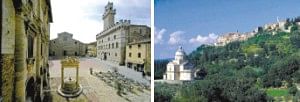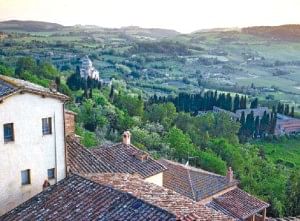|
A Roman Column
A Tuscan Town
Neeman Sobhan
 |
Piazza Grande. And view, foothill Montepulciano. |
After three decades of living in Italy and having 'done' umpteen times many of its celebrated sights and cities, I sometimes rouse myself from privileged complacency to revisit, with family or friends, places that we normally leave to the tourists.
Tuscany is one such region. Unless we are specifically visiting friends who live there, or our destination is some lesser known town in the area, we tend to avoid the over-popular Chianti zone and cities like Firenze, Siena, Montalcino, San Gimignano or Pienza.
But, the other day, with a visiting friend, my husband and I decided to return to one of our favourite hilltop cities of Tuscany and home of the local Vino Nobile wine: Montepulciano.
One of the highest, fortified towns, perched 600 metres above sea level, Montepulciano overlooks on all sides and from every opening of its steep alleys, panoramic views of the countryside around it: undulating expanse of vineyards; olive groves; fields of green and gold punctuated with rolls of hay; red tiled farmhouses bordered with cypresses; and hillocks topped with earth toned villages.
I have walked its steep, winding streets in every season. In late spring and summer, I have stopped to catch my breath at the outdoor cafe on the stony and stark Piazza Grande with its 15th century Palazzo Communale and tower, the 16th century Palazzo Tarugi, the severe facade of the Duomo and the delightful wishing well in one corner. In winter, when the alleys trap the whistling wind, and the scenic ledges are sharp with chilling blasts, we have found cosy cafes to drink hot chocolate while enjoying the glassed-in view as a painted canvas.
This time, at a Bar, my husband and I were surprised to find on the menu, drinks and food named 'al vampiro'! Vampires? Of course, we had not seen the recently released American film 'New Moon', and apparently, some scenes had been shot right here, on the main Piazza Grande of our Montepulciano.
I was amused. What a claim to fame! This was the same kind of banal publicity through which Cortona, another little town in Tuscany, had become the pilgrimage spot for those who had read or seen the film version of Frances Mayes' book, 'Under the Tuscan Sun.'
Sitting on a shaded and breezy terrace cafe, shielded from the unprecedented heat and sun of this scorching July, and sampling some of the local Pecorino cheeses and vegetable antipasti, I mused about the painterly quality of this country.
 |
Tuscan Vista. |
The lush beauty of the Italian countryside has figured not only on the artist's canvas for centuries, but in recent times, on the screens of many international and Hollywood films. Rome; Venice and the Adriatic sea; Lake Como; Florence and the other towns of Chianti-shire; the Mediterranean sea, the islands of Capri and Sicily, all have had a role in cinema as the backdrop of memorable films or as the only saving grace of mediocre ones.
Among the beautiful or watch-able films are: the classic Roman Holiday; Bertolucci's Stealing Beauty (Tuscany); The Talented Mr. Ripley (Ischia, Procida, Palermo, Anzio, Venice, Rome); The English Patient (Pienza and Arezzo in Tuscany, and even a hotel scene supposedly in Cairo was shot in the Grand Hotel des Bains in Venice and the Grand Hotel of Rome); the exquisite and award winning Il Postino (the island of Salina, off the coast of Sicily); and the surprisingly better- than- the- book-film Angels and Demons (all over Rome).
The films which one tolerates, just to have an excuse to sit back and be transported into the magic of Italy, are Only You, Under the Tuscan Sun, My House in Umbria etc. Some films have only incidental scenes that were shot in Italy, and I have often sat up and shouted out in recognition of the location. One of these occasions was when I once entered a room where kids were watching 'Star Wars Episode II: Attack of the Clones'. I started yelling, “Hey! That's Lake Como. The Villa del Balbienello!” before I was gently but firmly muffled and shown out of the room.
In Rome, we have seen the proliferation of the expensive 'Angels and Demons' tours, for what was traditionally part of a straightforward sight-seeing itinerary comprising locations famous in their own right: Piazza Navona and Bernini's Fountain of the Four Rivers; the Pantheon; or Castel Sant'Angelo. But if Dan Brown's thriller pushes tourists to trace fictive murders all the way to some out-of-the-way art work, like the sculpture of Bernini's 'Ecstasy of Santa Teresa' in the church of Santa Maria della Vittoria, or his sculpture 'Habkkuk and the Angel' in the Church of Santa Maria del Popolo, while discovering the paintings of Caravaggio and Pinturicchio on the way, I am happy.
If Audrey Hepburn and Gregory Peck put the Bocca della Verita or Mouth of Truth on the map of my parent's generation; and if the Fontana di Trevi remained alive in their minds as 'Three coins in the Fountain' then why should I mind if Montepulciano is on the itinerary of some younger generation Americans, simply for having certain scenes shot in this rugged Tuscan town.
While we relish our pastries and coffee, I observe a young couple at the table next to us sipping the famous wine of this town. From the winery or cantina up in the piazza they have bought a few bottles of the local wine. They ask conversationally why the Montepulciano wine they have had elsewhere was called Montepulciano d'Abruzzo.
The woman says, “After all, the town of Montepulciano is here in Tuscany and not in Abruzzo!” I turn to my husband who is more knowledgable.
Wines are known by the grapes, he says. The wines of this Tuscan town are fundamentally made of Sangiovese grapes, and after undergoing a two year maturing period, the result is deemed worthy of being labeled Vino Nobile di Montepulciano. But a certain type of grape, called confusingly enough, 'Montepulciano,' is grown in the distant Abruzzo region, and its wine is called simply, the Montepulciano of Abruzzo. It is cheaper and is neither Tuscan nor noble.
The couple still looks a bit confused but happily return to their now more exclusive wine and remark on the peace and beauty of this town. I don't ask them if they know of the turbulent history of this city's constant warfare with Florence and Siena, or of the harsh and lonely winters the locals endure. I don't ask them if they are here for the wine or the view or the jazz festival that evening. I don't ask them if they have seen 'New Moon' or the wedding scene shot a few feet away here on the Piazza Grande in 'Under the Tuscan Sun'. Whatever brings people to Montepulciano is only the starting point; what they leave with is often more than the pre-conceived notions and images they arrived with.
From up here on a stony ledge, Montepulciano is as 'real' and picture pretty as cinema, every view as timeless and unreal as a painting or photograph.
I too, click and capture my own version.
Copyright
(R) thedailystar.net 2010 |

